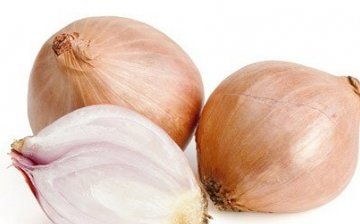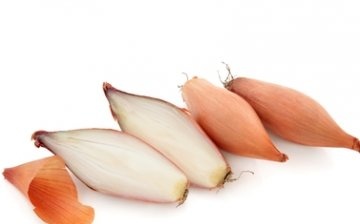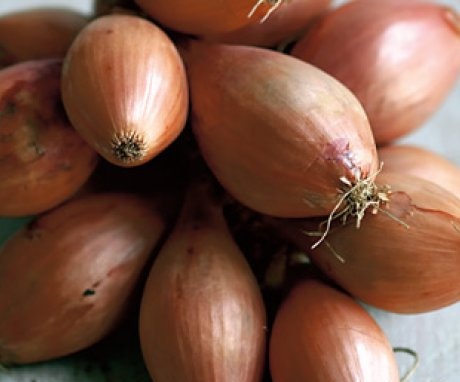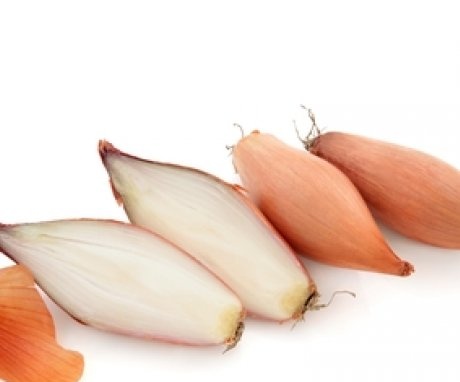Photo of shallots. Growing features
It is customary to grow onions to obtain large heads, which are used to prepare various dishes. But some types of onions are specially grown for the formation of lush and delicate greenery. Shallots are well suited for this purpose. It has a spicy and distinctive taste. Even some familiar dishes become more sophisticated if, when preparing them, the usual onion replace with shallots.
Content:
What is Shallot onion
As you can see in the photo, the head of the Shallot is small in size and consists of several "babies". Sometimes there can be up to 8-10 of them! For this reason, he is often called the family. One mother bulb is able to form a whole bunch of fragrant and nutritious greens, which does not coarse for a long time and remains juicy and healthy. For this reason, shallots are considered the most profitable crop for growing greens.
One of the main features of Shallot onions is that they ripen much faster than onions. Mature ripe bulbs are ready for harvesting 70-80 days ahead of onions in ripening by 28-35 days.
Shallots are not harvested before the onset of frost, but only the green feathers are cut off. For cutting, the onion is ready already 28-30 days after planting. Fragrant greens are used not only as a decoration for salads, but also as a nutritious product. The greens of onions are so delicate and pleasant that they do not drown out the taste of other products, but only enhance the taste effect.
The Shallot variety differs from ordinary onions in biological composition. It contains more minerals, sugar and ascorbic acid. It has high dietary and medicinal properties.
Shallot bulbs are very cold-resistant. If the morning frost has slightly "grabbed" the green onions, it quickly thaws and continues to grow without visible damage.
Another important distinguishing feature of Shallots is that they can last for a long time, until the next harvest. The bulbs do not dry out and do not sprout, even at room temperature. Not every type of onion can boast of this.
How to grow feathers and turnips from shallots
Dug up ripe onions are perfectly stored until spring. And already before landing it is dismantled for "kids". Smaller bulbs are planted separately to obtain greenery... It grows very juicy, tender and tasty. Larger bulbs are planted to grow new babies. They are heated at 40 degrees for 12 hours. This gives the plant strength, energy and increases disease resistance.
After a long winter and a long absence of natural greenery, you always want to eat it faster. To get an early harvest of green feathers, before landing the necks of the bulbs should be trimmed. They will begin to grow more intensively and after 16-18 days the greens can be cut off.
You can grow green shallots not only in the beds, but also on the windowsill or balcony, planting it in convenient containers or boxes. It is enough to stock up on earth and containers in the fall.
Shallots have a deep dormant period and should be planted at home starting in February. After about 28-30 days, the green feather is ready to cut. So you can provide your family with vitamin greens for the whole year.
After cutting the greens, the bulbs can be used to re-forcing the feathers.For this, the onion is cut in half, placed in a container and covered with earth. Onions planted in this way give a re-harvest of greens.
You can grow Shallot onions not only for feathers, but also for turnips. True, its yield is much lower than that of onions, but it “helps out” when the onions have not grown enough yet. To obtain larger onion heads, the “kids” are planted at a distance of at least 10 cm, and a distance of at least 20 cm is kept between the rows. This space is quite enough for the growth of shallots.
Features of growing shallots
It is better to plant onions in a sunny area of the garden, having prepared for this a bed with loose earth. The soil should be loosened periodically throughout the onion growth period and at the same time make sure that the weeds do not interfere with the growth of the bulbs. They are constantly removed each time the soil is loosened. Top dressing with ash and superphosphate has a good effect on the yield of onions.
During growth, it is imperative to prune the onion to prevent the arrowing to which it is so prone. After the green feather has grown, you can pull out the feathers of the onion with the head, leaving two onions in the rosettes. In this case, you need to dilute them to the sides, sprinkle them with earth and compact. So you can eat young fresh onions throughout the entire growth period, and in August you can get not only new ones the seeds for future planting, but also full-fledged bulbs.
In dry and hot weather, shallots are watered, but this should be done no more than once a week. Onions require intensive watering only at the beginning of the growing season. Watering is stopped a month before the onion harvest. Onions are usually harvested at the end of July. Do not hesitate with harvesting, otherwise the family will disintegrate, and the bulbs will start growing again.













